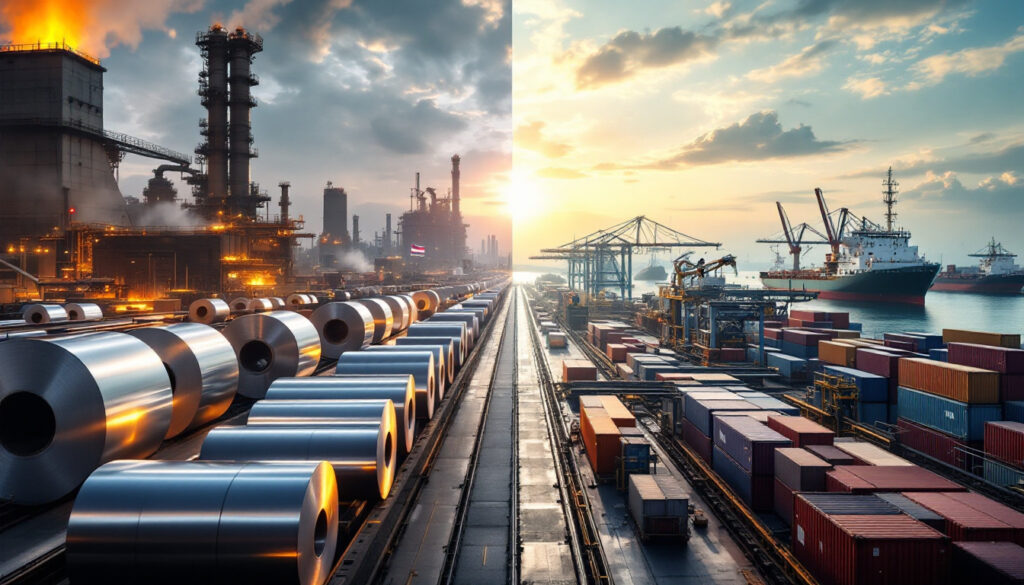China's Aluminum Industry: Navigating Global Tariffs and Expansion Strategies
Chinese aluminum producers continue to dominate global markets despite escalating trade tensions, with strategic overseas expansions and competitive pricing enabling sustained growth. Recent developments highlight a 7% quarterly export decline in early 2025 alongside renewed confidence in international demand, underscoring the industry's resilience amid protectionist measures.
How Are Chinese Aluminum Producers Responding to US Tariffs?
China's Strategic Overseas Expansion Continues Despite Trade Barriers
Chinese aluminum makers remain committed to international growth despite the 25% blanket tariffs imposed by the Trump administration. Manufacturers like Jiangsu Dingsheng New Materials Co. have explicitly confirmed their intention to "stick to expansions overseas" with established production bases already operating in Thailand and Europe.
This determination reflects a calculated response to both external trade barriers and internal challenges. Domestic capacity constraints are increasingly driving these manufacturers to seek international production opportunities, creating a more distributed global footprint for China's aluminum industry.
The Impact of US Tariffs on Chinese Aluminum Exports
The effects of ongoing trade tensions are becoming measurable. Chinese aluminum exports fell by more than 7% in Q1 2025, dropping to 1.37 million tons. Industry analysts attribute this decline primarily to the removal of a tax rebate that previously fueled the decades-long export boom from Chinese producers.
Despite these headwinds, industry executives describe being "numb to tariffs" after years of trade restrictions from Western countries. This sentiment reflects the sector's adaptive capacity and experience navigating protectionist measures targeting China's aluminum makers and tariffs imposed by various nations.
Why Are Chinese Aluminum Makers Confident Despite Trade Tensions?
Competitive Advantages Sustaining Global Demand
Chinese producers consistently cite robust demand for their metal from markets outside the US as a primary reason for their continued confidence. He Zhigang, deputy GM of Henan Mingtai Al. Industrial Co., emphasizes that Chinese aluminum remains competitive globally due to fundamental cost and scale advantages that transcend individual market restrictions.
The industry's resilience is further evidenced by executives' beliefs that they only "need a bit time to overcome this round of anti-dumping from the US." This perspective highlights their confidence in the structural competitiveness of Chinese production, which combines state-of-the-art facilities with economies of scale unmatched by Western competitors.
Domestic Market Challenges Driving International Expansion
Paradoxically, the "big pressure" on domestic capacity has become a key motivation for overseas growth. Chinese aluminum fabricators, while dominating global capacity, face significant oversupply issues at home that necessitate international market development.
This domestic glut explains why foreign competitors continue to complain about Chinese producers "flooding the market" even as the manufacturers themselves struggle with thin margins and overcapacity. The international expansion strategy thus serves dual purposes: circumventing trade barriers while alleviating domestic market saturation.
What Is the Current State of the Global Aluminum Market?
Recent Price Movements and Market Conditions
Aluminum futures were trading at $2,318.75 per ton as of April 17, 2025, down 1.36% in a market experiencing heightened volatility. This price movement reflects ongoing uncertainty amid trade tensions and significant policy changes affecting global commodities insights.
China's export restrictions impact has particularly affected global aluminum markets, introducing new dynamics into price discovery mechanisms and trade flows. As Chinese producers adapt their strategies, price volatility has become an expected feature of the market landscape.
The Broader Impact of Trade Wars on Metal Markets
The aluminum sector's challenges exist within a broader context of escalating trade tensions. Gold prices have surpassed $3,300 to reach new records as the tariff war intensifies, demonstrating investor flight to safe-haven assets amid industrial market uncertainty.
Trump's trade policies have ordered probes into possible tariffs on all critical minerals imports, further complicating the outlook for aluminum producers worldwide. Even US aluminum producer Alcoa has reported $20 million in tariff costs on imports from Canada, illustrating how protectionist measures often have unintended consequences across supply chains.
What Are the Implications for Global Aluminum Supply Chains?
Restructuring of International Production Networks
Chinese manufacturers are strategically establishing production bases in countries with better market access, fundamentally restructuring global aluminum supply chains. Thailand and Europe have emerged as particularly important manufacturing hubs for Chinese aluminum companies seeking to maintain market presence despite trade barriers.
This geographical diversification represents a sophisticated adaptation to the new trade reality. Rather than abandoning markets subject to tariffs, Chinese aluminum makers are reconfiguring their production networks to ensure continued access while minimizing the impact of trade restrictions.
Future Outlook for Chinese Aluminum Producers
The industry expects continued growth despite international trade challenges, with manufacturers projecting confidence in their ability to compete in global markets. However, this optimism comes with recognition of increased competition in third-country markets as Chinese exports redirect from the US to alternative destinations.
The ongoing evolution of global aluminum supply chains reflects a dynamic response to changing trade policies. Chinese producers appear positioned to maintain their central role in global markets through strategic adaptation rather than retrenchment, suggesting that trade barriers may reshape rather than reduce their global influence.
FAQ About China's Aluminum Industry and Global Trade
How significant is China in the global aluminum market?
China dominates global aluminum production capacity and has been a major exporter for decades, reshaping international supply chains and pricing dynamics. The country accounts for more than half of global primary aluminum production, giving Chinese producers substantial influence over market conditions despite trade restrictions.
What specific tariffs has the US imposed on Chinese aluminum?
The Trump administration has implemented blanket 25% tariffs on all aluminum imports, including those from China, citing harm to US manufacturing. These measures are part of broader trade tensions between the world's two largest economies that have transformed metal markets globally.
How are Chinese aluminum producers adapting to international trade barriers?
Chinese manufacturers are establishing production facilities in countries like Thailand and European nations to circumvent tariffs while maintaining access to global markets. This strategy allows them to leverage preferential trade agreements between these countries and target markets while maintaining cost advantages inherent in Chinese supply chains and expertise.
What caused the recent decline in Chinese aluminum exports?
Chinese aluminum exports fell by more than 7% in Q1 2025 primarily due to the removal of a tax rebate that had previously incentivized exports. This policy change, combined with intensified trade barriers, has prompted Chinese aluminum makers to reconsider their global strategies and accelerate overseas production investments.
Are US tariffs effectively reducing Chinese aluminum market dominance?
While tariffs have reduced direct exports to the US, Chinese producers remain confident in their global competitiveness and are adapting through international expansion rather than scaling back operations. The geographic redistribution of production may ultimately strengthen their position by creating more resilient and diversified supply chains, with some manufacturers focusing on low-carbon aluminium project development to meet evolving market demands amid China's economic stimulus.
Want to Stay Ahead of Major Mining Discoveries on the ASX?
Discover potentially transformative ASX mining announcements as they happen with Discovery Alert's proprietary Discovery IQ model, which constantly analyses market data to identify high-potential opportunities before they mainstream. Explore how significant mineral discoveries have generated substantial returns by visiting Discovery Alert's dedicated discoveries page.




